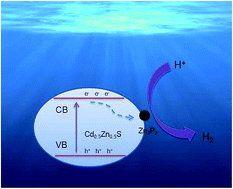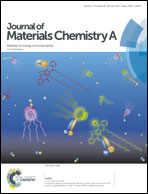Dramatic enhancement of the photocatalytic activity of Cd0.5Zn0.5S nanosheets via phosphorization calcination for visible-light-driven H2 evolution†
Abstract
In the present work, phosphorized Cd0.5Zn0.5S nanosheets were prepared through a hydrothermal process followed by phosphorization calcination at 500 °C. Meanwhile, the photocatalytic activity of the as-prepared phosphorized Cd0.5Zn0.5S nanosheets was explored for H2 evolution from water under visible light irradiation. The results indicate that the photocatalytic activity of the Cd0.5Zn0.5S nanosheets can be dramatically enhanced by phosphorization. Under optimal conditions, the H2 evolution rate over the phosphorized Cd0.5Zn0.5S nanosheets is up to 22.5 mmol h−1 g−1, and the apparent quantum efficiency is about 4.6% at 450 nm, which is 1.3 times higher than that over the pure Cd0.5Zn0.5S nanosheets. Furthermore, the photocatalytic mechanism was preliminarily discussed. It is found that the aforementioned enhancement of the photocatalytic activity may be ascribed to the introduction of Zn3P2 clusters. Here, the Zn3P2 clusters serve as charge transferring sites and/or active sites, which leads to efficient separation of the photogenerated electrons and holes, fast charge transfer and a lower hydrogen overpotential.



 Please wait while we load your content...
Please wait while we load your content...